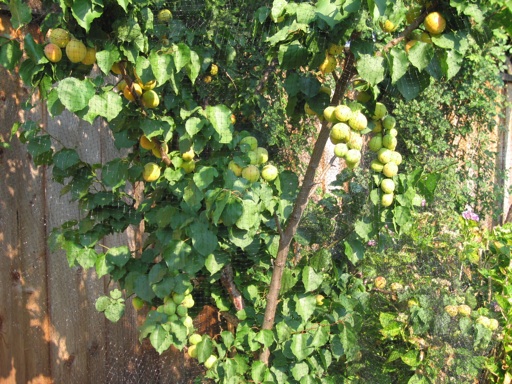Blenheim Apricots Ripening
Blenheim apricot tree with netting
I have fond memories of picking apricots from our Blenheim apricot tree in the summertime when I was growing up. We would eat them fresh, and my mom would cook apricot cobbler and apricot jam.
The fruit on the Blenheim apricot tree in my backyard is ripening this week, and they taste delicious. The fruit is very sweet with only a hint of tartness. Tree-ripened Blenheim apricots are the best tasting apricots. By tree-ripened, I mean apricots that are left on the tree until they are not only orange in color, but soft to touch. When the surface of the fruit is mostly hard when squeezed, it is not ready yet. Ideally, an apricot should be left on the tree until it is soft enough to make a small dent in the flesh. Usually, an apricot becomes soft enough to eat about week after beginning to turn orange.
Blenheim apricots often are not completely orange even when ripe. The side of the apricot that is exposed to the sun tends to turn orange, while the side of the apricot that is shaded from the sun may be a bit green or yellow, although the inside is soft and sweet. A Blenheim apricot will often have a characteristic greenish or yellowish cast on one side that distinguishes it from many of the commercially sold apricots that one finds in a grocery store.
I have heard that one of the reasons that fresh Blenheim apricots are rarely sold in grocery stores these days is because customers rarely select them due to their non-uniform color. Also, Blenheim apricots tend to rot a few days after they ripen. So, they do not have a long shelf life, and they are unsuitable for transport over long distances. That’s too bad, because Blenheim apricots are really the best tasting apricots in my opinion. It seems that the only way you can get them anymore is by growing a tree in your backyard.
Squirrels are the main problem I have had with growing apricots. Squirrels love apricots. They take them off the tree just as they are beginning to turn orange, before I consider them to be ripe. Squirrels in my area will strip all of the fruit off a tree in a matter of days. The only solution that works is to wrap the tree with bird netting. Every winter I trim the tree down to a height of about 10 feet tall. Fruit trees do not develop fruit on newly grown branches. Therefore, topping the tree to 10 feet ensures that the tree only develops fruit on the lower branches.
I only need to net the lower part of the tree, which requires a lot less effort than netting the full canopy. I use clothes pins to secure the net to the branches, and make sure that the net is wrapped around the inside branches as much as possible so that the squirrels can’t access the fruit by jumping past the net into the inner branches. Also I wrap part of the net around the trunk, and tie it with string so they can’t crawl up the trunk through a gap in the net. I have hardly lost any apricots to squirrels this way!
Blenheim apricots grow great in California. But because they bloom early (e.g., the first week of March in our area in 2008), they are hard to grow in regions that are prone to late frosts. A late frost could damage the blossoms or newly developing fruit.
July 13 2008 08:47 pm | Apricots
